If anyone sees one, I would be very interested in an chart, graph, or infographic that shows how this landing was different (higher, faster, harder, etc.) than the last landing. A while back there were some nice pictures that showed how the SpaceX landing was different/harder than the Blue Origin landing. Something like that would be useful in explaining to my non-geek friends why this is a big deal.
You are using an out of date browser. It may not display this or other websites correctly.
You should upgrade or use an alternative browser.
You should upgrade or use an alternative browser.
SpaceX Falcon 9 historic landing thread (1st landing attempt & most recent missions)
- Thread starter georgegassaway
- Start date

Help Support The Rocketry Forum:
This site may earn a commission from merchant affiliate
links, including eBay, Amazon, and others.
If anyone sees one, I would be very interested in an chart, graph, or infographic that shows how this landing was different (higher, faster, harder, etc.) than the last landing. A while back there were some nice pictures that showed how the SpaceX landing was different/harder than the Blue Origin landing. Something like that would be useful in explaining to my non-geek friends why this is a big deal.
Blue Origin was straight up, payload was deployed that also fell back to earth, then rocket came straight back down and landed on land. This is amazing in itself, but what SpaceX is doing is on an order of X magnitude more complicated.
SpaceX is delivering payloads into a sustained orbit. This requires the booster to travel at much faster velocities as well as arc over in it's trajectory in order to inject the payload into orbit. In the case of the JCSAT-14 launch the booster hit about 8,500 Km/h and it continued up to an apogee likely in excess of 100K but I cannot find the exact numbers, then it has to turn around to slow down and boost back for reentry. The previous launch it hit about 6,600 Km/h and the apogee was likely much less simply due to the lower velocities at MECO. These higher apogees and velocities add a lot of friction during reentry that the rocket has to be able to handle. On top of this SpaceX is not landing on land they are landing on a moving target.
I am sure I am missing something but this is the basics of it.
EXPjawa
Well-Known Member
I get the idea that he grasps all of that, but was just looking for something like the infographic that came out a little while back that explained it all pictographically, that way he could show others. Something that showed the relative difference between the different type of missions (geotransfer vs LEO vs ISS service, etc). Then maybe it should include an image of the Blue Origin flight path, accompanied by a tiny marker saying "you are here", thus putting it all in Total Perspective...
- Joined
- Jan 17, 2009
- Messages
- 5,204
- Reaction score
- 1,547
If anyone sees one, I would be very interested in an chart, graph, or infographic that shows how this landing was different (higher, faster, harder, etc.) than the last landing. A while back there were some nice pictures that showed how the SpaceX landing was different/harder than the Blue Origin landing. Something like that would be useful in explaining to my non-geek friends why this is a big deal.
First of all, you need to understand the normal landing burns. After the second stage has separate,d the first stage does a turnaround and the uses three engines for Boostback.
If the payload was light enough , there can be enough fuel left for the boost back burn to push it BACK to the launch site (well, ballistically a few miles shy of the coast). Which is what was done for the Orbcomm-2 flight, which did a successful RTLS landing back at the Cape in December.
But for heavier payloads, there is not enough fuel to boost it all the way BACK, but it can still boost part of the way back, so that for an ASDS landing, the barge does not have to be as far out in the ocean.
In any case, there has always been a boost back burn, with three engines (center and two sides). Then when the booster begins to re-enter the atmosphere,e there is a reentry burn (3 engines again) which helps to slow the rocket down some so that the re-entry heating is not as severe. Also the rocket exhaust produces a bow wave effect that reduces re-entry heating. The re-entry burn also helps with targeting/steering , in addition to the Grid Fins which aerodynamically steer the rocket from some portion of re-entry to landing.
Finally, the landing burn, using ONE engine. It usually ignites about 30 seconds before touchdown. It can be throttled somewhat, but the MINIMUM throttle is greater thrust than the weight of the rocket! So, it can never hover. The landing has to be very accurate in descent rate, so that for example, the rocket would reach ZERO velocity at say 8 feet below the ground / deck. So before it would reach zero velocity asa few feet below the landing surface it has already touched down, softly (if things went well). So, here is a drawing that shows boost back and re-entry and landing burns in a somewhat simplistic way, the boost back for ASDS landings does not result in a purely vertical drop for reentry and landing, but its good to understand what the burns do.
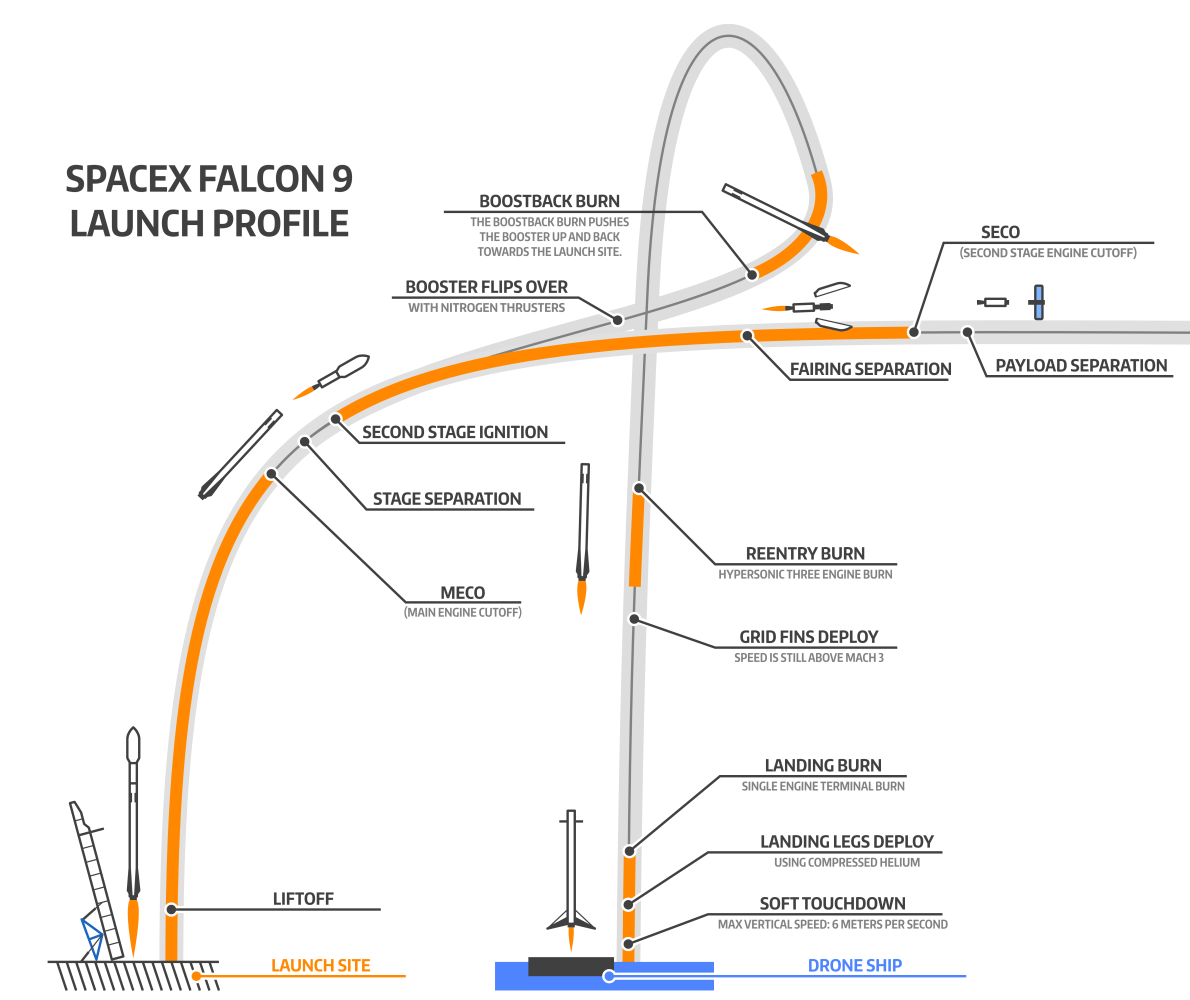
So, what was different for SES-9 and JCST-14, you asked? Those satellites are very heavy, and need to be put into a Geostationary Transfer Orbit which requires more fuel than to say fly into the same orbit as ISS. Until SpaceX upgraded the Falcon-9 last fall, they would have flown SES-9 and this flight as expendable flights. Indeed once they started to try landings in early 2015, there were some expendable launches, not enough fuel left to try for landing.
With the current Falcon . it is JUST barely possible to maybe land, but sacrifices have to be made. The biggest is the boost back burn, there is no boostback burn. So when the Falcon booster flips around, the only maneuvers it can do at first is .. nothing .. because it high above the atmosphere,e so the grid fins have no air. Oh, also on these flights, IIRC, they were lofted a bit higher, so the re-entry is more severe.
So, they are coming in hot, no boost back burn. The ASDS has to be near to where the booster would splash down ballistically. Also, the re-entry burn apparently is not done with as much fuel as usual, so it is not quite as effective. So one of the biggest issues was whether the boosters could even survive the re-entry and still be controllable.
And then, the really incredible landing burn. I said the burn lasts about 30 seconds. Well, as it is being slowed by the thrust,t there are also gravity losses, the rocket wants to fall faster at 32 feet a second every second. So, the faster it can LAND, the less fuel it needs. So for SES-9, and for this one, they let it fall to a LOT LOWER altitude than it would normally be when the center engine ignites for the 30 second landing burn. And then, falling WAY faster than normal for a given altitude after a normal landing burn wild have begun, it ignited THREE engines! So it had three times the potential thrust, and could stop quicker. Of course three engines use three times as much fuel, but because the gravity losses are greatly reduced by landing much sooner after ignition, it does not need as much fuel to land on 3 engines as it needs to land on one engine.
But many risks with that, controllability, incredibly more precision needed, and so forth. Reportedly, the SES-9 fight was coming down OK, and under control, but it ran out of fuel. This one, they did some tweaks, and perhaps the payload was not quite as heavy or it was otherwise able to have little bit more fuel left in the booster to try this kind of landing again.
When I first hear of this a few moths ago, for SES-9, it sounded crazy. Never mind the re-entry heating issues, they had never done any testing to support such a high-speed triple thrust level landing. I really didnt think it would work. It was incredible to see, after all that bright light and then nothing, along with some loss of signal, to see the Falcon on the deck, almost like Scotty beamed it there.
- George Gassaway
Last edited:
Right. I know all that. But has anyone seen such an infographic, similar to what you posted, that compares the first SpaceX landing to the second that makes it plain to the layman, who isn't a rocket geek like us, what the differences were?
dixontj93060
Well-Known Member
- Joined
- Feb 19, 2009
- Messages
- 13,083
- Reaction score
- 45
Great info for us neophytes in post #1144!
jeff_j_black
Well-Known Member
- Joined
- Oct 31, 2014
- Messages
- 235
- Reaction score
- 2
I think that they are accumulating Falcons at KSC so that they can build the heavy! Each successful landing is another piece of the puzzle.
- Joined
- Jan 17, 2009
- Messages
- 5,204
- Reaction score
- 1,547
I think that they are accumulating Falcons at KSC so that they can build the heavy! Each successful landing is another piece of the puzzle.
Well, the Heavy needs modified boosters. The Center core needs pairs of attachment fittings 180 degrees apart, and each outer booster needs corresponding fittings on one side (I suspect that there will not be "left booster" and "right booster" fittings, so they could use any two outer boosters with a given central core). There also needs to be some sort of separation mechanism, which might be mechanical as opposed to small separation rockets.
In any case the first one will never fly again, it's going to be displayed outside of SpaceX HQ in California. The second one, is going to be static test fired about 10 times (originally Musk said fired at the Cape, such as at Pad 39A. But mods to 39A is behind schedule, and on the hosted webcast they said it MIGHT end up being test fired in McGregor, which was new news). If it passes testing, Musk said it would fly again in May or June. Well, that is what he said a month ago, which I automatically translated into "summer", and, well, with no test firing at all yet, maybe by end of year if it passes testing?
Nothing mentioned yet about plans for the third one that landed successfully, other than needing more storage space. It got pretty "toasted", so there may be a lot more teardown and study of it to see what areas may need to be modified to handle re-entries that hot, so that such flights would still allow a lot of re-use (or maybe they find out that really "hot" re-entries will reduce the potential number of reusable flights by a large amount.) In any case, I would be really surprised if #2 or #3 were used for a later Falcon Heavy, they'd need to be modified (which maybe "hard points" already exist to allow such retrofits, or maybe it's not practical to do other than during original fabrication).
On to other things....
Can’t find the quote at the moment, but it turns out that the three engine landing was actually a MOSTLY three engine landing, with the two outer engines shut down so the final landing could be made on the single core engine. THAT makes a LOT more sense, since having triple the thrust for landing all the way to the deck would be so tricky for control the last moments before landing. Indeed I had suggested that very possibility on NSF, shut down the other two a bit early, and the idea was treated with incredulity by some people I thought were experts but realize more and more that some of them ain’t (like REALLY? Claiming Space could not get the valves to shut down fuel to two outer engines at the same time???).
Unfortunately SpaceX says so little that there is so much speculation in-between the dribs and drabs until sometimes little bits of info are released that fill in some of the gaps, and either confirm some speculation or blows some of it away (or the occasional tweet that says something…… that causes further confusion. And change of plans that are not mentioned until far far down the road (Long-ago plans for Falcon-Heavy to use Fuel Cross-feed is dead. That was only very recently announced. It works so well in KSP….
Anyway… moving away from digressing and back to “gressing”…..
This drawing is more accurate for how many of the ASDS barge landings have been done. Though it does show the boost back burn, which SES-9 and JCSAT-14 flights did not have.

I only found this a few minutes ago, in the Technical webcast, starting at about 29:20. Shortly after, there is video shot from one of the support ships, showing the landing for around 10 miles away (Safety zone 10 miles IIRC). It’s a far off small image but a big bag of light….. until it is not a ball of light anymore. The Hosted Webcast either did to have this or the director changed to the shot too late (realize that there seems to be some time sync mismatches that could be due to how the “live” streams were sent, and also the landing Falcon once again “rattled” the barge’s uplink system which is why one moment there was a lot of light from above, screen freeze, then an intact Falcon core string on the deck.
[video=youtube;1lYZLxr3L4E]https://www.youtube.com/watch?v=1lYZLxr3L4E?t=1770[/video]
I expect sometime soon they will have video that was recorded onboard the ASDS barge and relate that. Maybe even the 360 degree camera again.
And now…. some pics from the Atlantic Friday…..
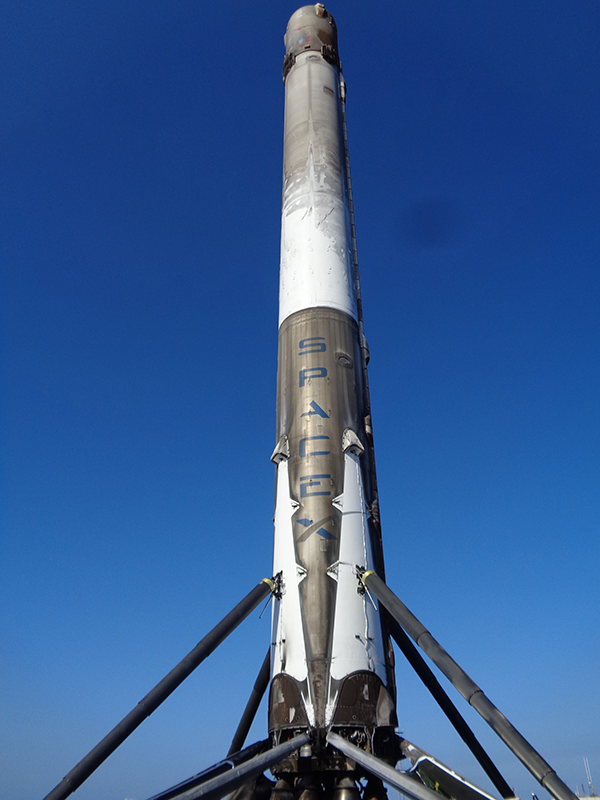
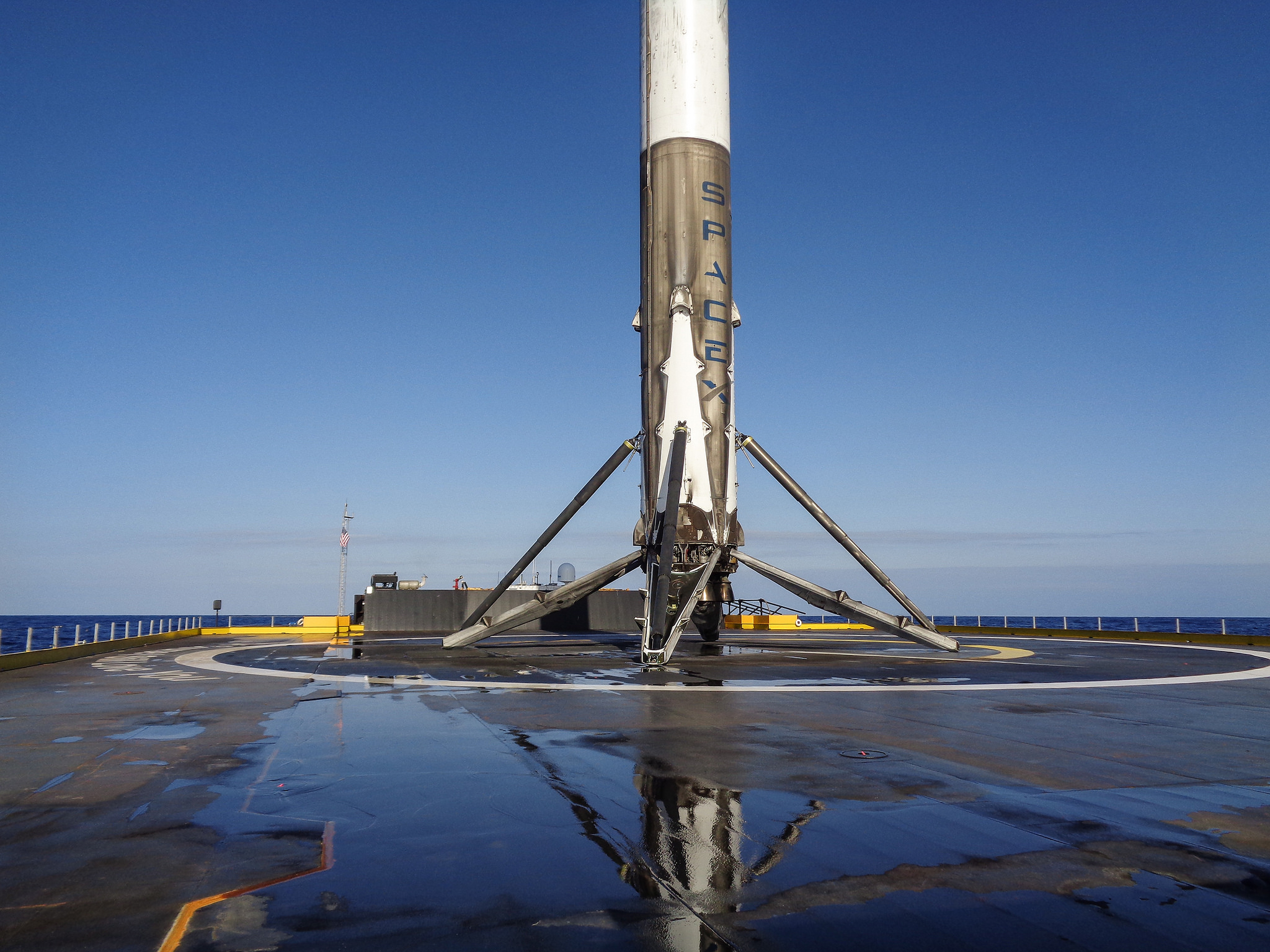
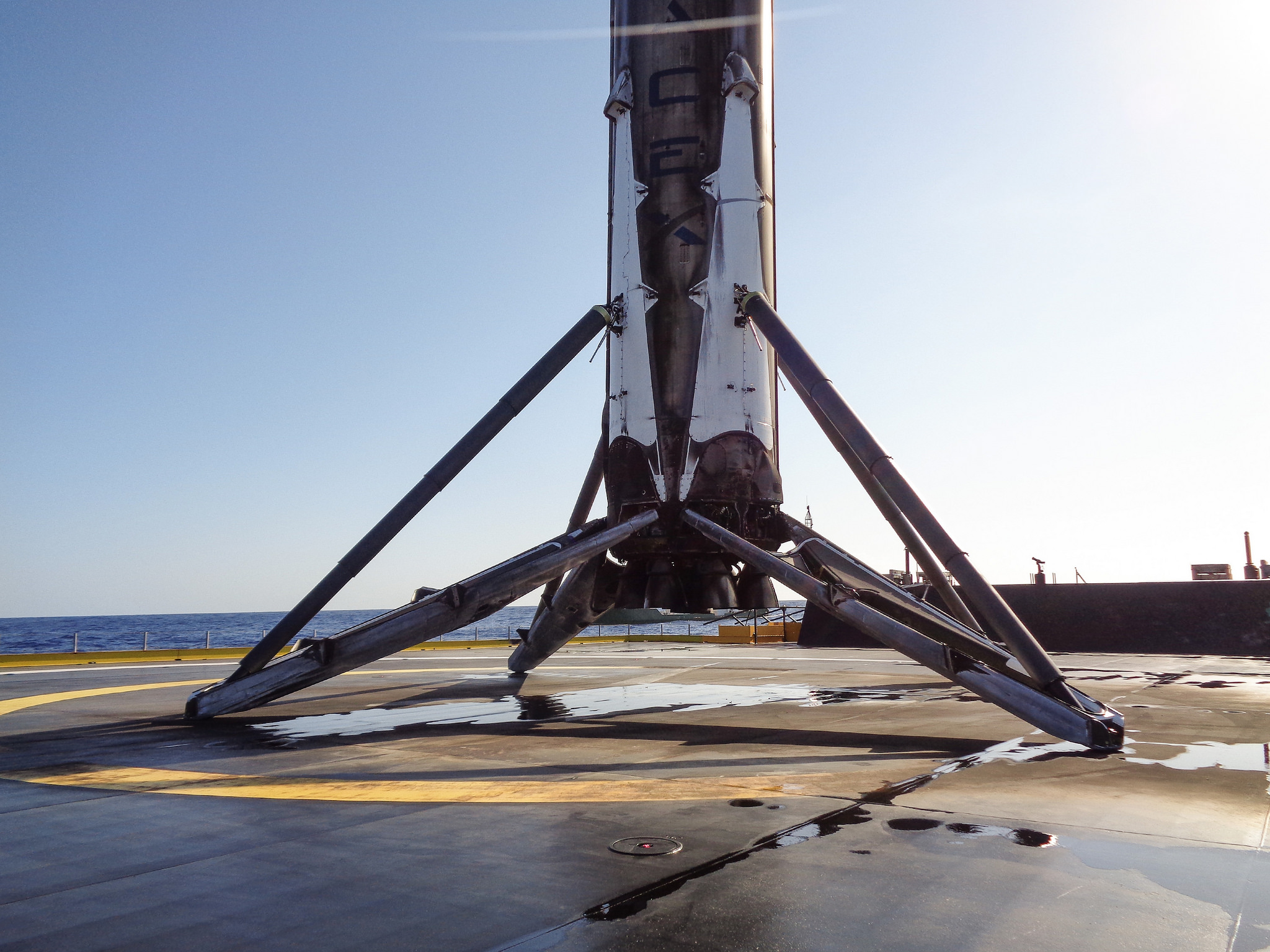
Last edited:
Rex R
LV2
- Joined
- Apr 21, 2010
- Messages
- 6,392
- Reaction score
- 384
ya know, all these powered landings are good practice for landing elsewhere...makes me wonder when they're going to put simulated 'rocks'* on the landing pad to simulate a mars landing.
*I would imagine that radar reflective paint could be used and still leave a flat surface for the first few landings. objective would be to 'avoid' putting a leg on a rock.
Rex
*I would imagine that radar reflective paint could be used and still leave a flat surface for the first few landings. objective would be to 'avoid' putting a leg on a rock.
Rex
SpaceManMat
Space Nut
- Joined
- Dec 20, 2013
- Messages
- 702
- Reaction score
- 86
Well, the Heavy needs modified boosters. The Center core needs pairs of attachment fittings 180 degrees apart, and each outer booster needs corresponding fittings on one side (I suspect that there will not be "left booster" and "right booster" fittings, so they could use any two outer boosters with a given central core). There also needs to be some sort of separation mechanism, which might be mechanical as opposed to small separation rockets.
Pretty sure I read that the last major upgrade included changes so they did not have to produce separate cores. I take this to mean that it is reasonably straight forward to bolt on the extras required to build the falcon heavy. Having said that there is no way they are going to do experimental reuse for a first flight of falcon heavy.
Unfortunately SpaceX says so little that there is so much speculation in-between the dribs and drabs until sometimes little bits of info are released that fill in some of the gaps, and either confirm some speculation or blows some of it away (or the occasional tweet that says something…… that causes further confusion. And change of plans that are not mentioned until far far down the road (Long-ago plans for Falcon-Heavy to use Fuel Cross-feed is dead. That was only very recently announced. It works so well in KSP….)
if you've not seen before you should check out some of videos on u tube about the companies methods. In order to get things done quickly they make decisions once they have more than 50% certainly, so they move ahead at an extremely rapid pace. Which does mean from time to time they need to back track, this is probably why they keep their plans to themselves as the media tend to look down on any change of plan as evidence of incompency. Of course as can be seen recently with the Mars plan announcement they are infact many steps ahead of what is immediately obvious in that they have been collecting data on controlling spacecraft for a Mars landing for quite some time.
SpaceManMat
Space Nut
- Joined
- Dec 20, 2013
- Messages
- 702
- Reaction score
- 86
[video=youtube_share;bUiIhyhp0XU]https://youtu.be/bUiIhyhp0XU[/video]
[video=youtube_share;P06X2TZUKZU]https://youtu.be/P06X2TZUKZU[/video]
[video=youtube_share;P06X2TZUKZU]https://youtu.be/P06X2TZUKZU[/video]
[video=youtube_share;bUiIhyhp0XU]https://youtu.be/bUiIhyhp0XU[/video]
[video=youtube_share;P06X2TZUKZU]https://youtu.be/P06X2TZUKZU[/video]
Very interesting to hear someone from NASA explain, what I view as an outsider, an accurate perspective of the differences between NASA and the SpaceX culture. I know the folks at NASA are obviously a very intelligent group of people, but I had come to the conclusion over the years that they were too close to their issues to see them clearly. Perhaps this is one of the success stories that will come out of SpaceX, that is to wake up the giant.
Thanks for the post!
dixontj93060
Well-Known Member
- Joined
- Feb 19, 2009
- Messages
- 13,083
- Reaction score
- 45
Yes thanks. Video #2 is pretty telling. What a huge difference between a real leader and a hive of bureaucrats!
Bureaucracy is the glue that greases the wheels of government...
KerryQuinn
Well-Known Member
- Joined
- May 5, 2009
- Messages
- 136
- Reaction score
- 0
terryg
Well-Known Member
I wonder what the time frame is for man rateing the falcon? It's about time that we restore our ability to get back into space.
Last edited:
Is there any good video of this recent landing yet?
Is there any good video of this recent landing yet?
Beyond the one from the webcast as well as the one posted on YouTube [video=youtube;vrLJ3jCgn84]https://www.youtube.com/watch?v=vrLJ3jCgn84[/video], post landing, which looks to be taken from another ship I have yet to see any additional video. There were the high res still posted by George, sourced here https://imgur.com/gallery/1p7R4.
It looks like the barge is past the half way mark home https://drive.google.com/file/d/1iCXYDfLeRK0FCgzQK7u1UE1SybY/view?pref=2&pli=1
Apparently, the "real-time" position of OCISLY can be found here, I believe it is either the "Tub and special craft" or the one following it "Cargo vessel". https://www.marinetraffic.com/en/ais/home/centerx:-78/centery:28/zoom:10
John -
Here are the comparisons that *I* think show a comparison of the Blue Origin and Spacex landings....
-Kerry
View attachment 290403View attachment 290404
Kerry,
That's exactly the comparison I mentioned seeing. What I would love to find is one, similar to this format, that somehow compares the two SpaceX landings to show why this last one was so much more difficult. I understand it, but explaining it to non-technical people can be difficult.
- Joined
- Jan 17, 2009
- Messages
- 5,204
- Reaction score
- 1,547
That's exactly the comparison I mentioned seeing. What I would love to find is one, similar to this format, that somehow compares the two SpaceX landings to show why this last one was so much more difficult. I understand it, but explaining it to non-technical people can be difficult.
I looked around but did not find anything that shows visually the difference between the "normal" ASDS landings with a boostback burn, and the "hot" re-entries without a boostback as SES-9 and JCSAT-14 boosters had. It may be that the ones who do appreciate the difference, who might create such a drawing, just figure the rest who are into this stuff understand it anyway.
Or possibly there's enough uncertainty about EXACTLY what is going on with the re-entry burn and landing burn that nobody with the drawing skills want to create a "definitive" drawing that is not going to be accurate. For example, the 3-engine suicide burn was only recently revealed by Musk to be 3 engines for awhile, then two shut down to land on one engine as it usually does (BTW - a landing simulation indicated the likely shutdown altitude of the outer two engines was at 200 feet).
Also, great uncertainty now, about the re-entry burn duration, throttle, and altitude. Did it start before getting deep into the atmosphere? Was it partial throttle? References to it being 7 seconds and 17 seconds, if 17 seconds it would have to be at partial throttle given the apparent limited fuel that could be spared.
No new video released yet, but doubtless there should be some from recordings onboard OCISLY and perhaps a camera on the booster (might have been overexposed by the exhaust). Hopefully the 360 degree camera again.
The ASDS barge with booster is likely to arrive in Port Canaveral late tonight.
A recently released image:
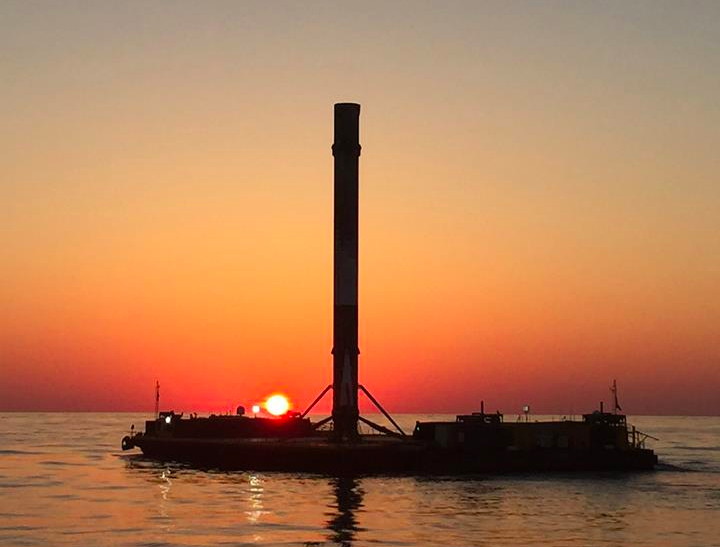
Last edited:
Winston
Lorenzo von Matterhorn
- Joined
- Jan 31, 2009
- Messages
- 9,560
- Reaction score
- 1,749
From the presentation of an actual study:Bureaucracy is the glue that greases the wheels of government...

- Joined
- Jan 17, 2009
- Messages
- 5,204
- Reaction score
- 1,547
.
.
Let's avoid gubmint-bashing in this thread PLEASE.
.
.
.
Let's avoid gubmint-bashing in this thread PLEASE.
.
.
Last edited:
- Joined
- Jan 17, 2009
- Messages
- 5,204
- Reaction score
- 1,547
Here's an image taken from the coastline.
Maybe be arriving in port at about 10 PM EDT.
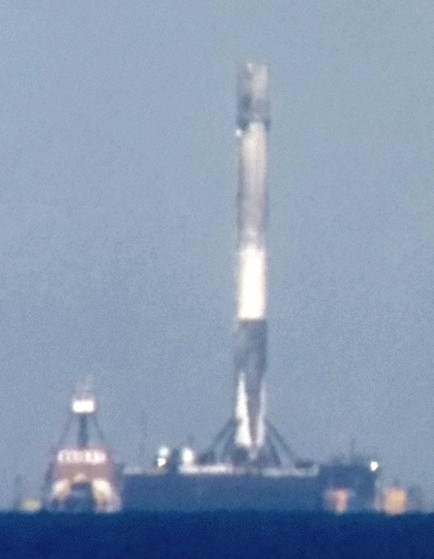
Maybe be arriving in port at about 10 PM EDT.

Last edited:
- Joined
- Jan 17, 2009
- Messages
- 5,204
- Reaction score
- 1,547
LANDING VIDEO Times THREE!
[video=youtube;LHqLz9ni0Bo]https://www.youtube.com/watch?v=LHqLz9ni0Bo[/video]
[video=youtube;LHqLz9ni0Bo]https://www.youtube.com/watch?v=LHqLz9ni0Bo[/video]
SpaceManMat
Space Nut
- Joined
- Dec 20, 2013
- Messages
- 702
- Reaction score
- 86
Now that's just a little bit hot. Hard to tell but it appears to have moved around, perhaps even more than the last time.
Sooner Boomer
Well-Known Member
- Joined
- Mar 21, 2011
- Messages
- 5,901
- Reaction score
- 4,883
Now that's just a little bit hot. Hard to tell but it appears to have moved around, perhaps even more than the last time.
Yeah, it looks like in the second video (second camera view) that it skidded a few feet when it landed.
- Joined
- Jul 23, 2012
- Messages
- 1,900
- Reaction score
- 874
LANDING VIDEO Times THREE!
[video=youtube;LHqLz9ni0Bo]https://www.youtube.com/watch?v=LHqLz9ni0Bo[/video]
Now that is just all kinds of badass right there.
At the start of the footage from the second angle you can see how much the barge is heaving against the sea. So it might not be too surprising there was some sideslip at touchdown.
And do my eyes deceive me or in the third view can you see the two outer engines shutting down? Someone please verify, I'm not totally sure.
Similar threads
- Replies
- 5
- Views
- 626
- Replies
- 7
- Views
- 624
- Replies
- 29
- Views
- 2K
- Replies
- 6
- Views
- 2K









